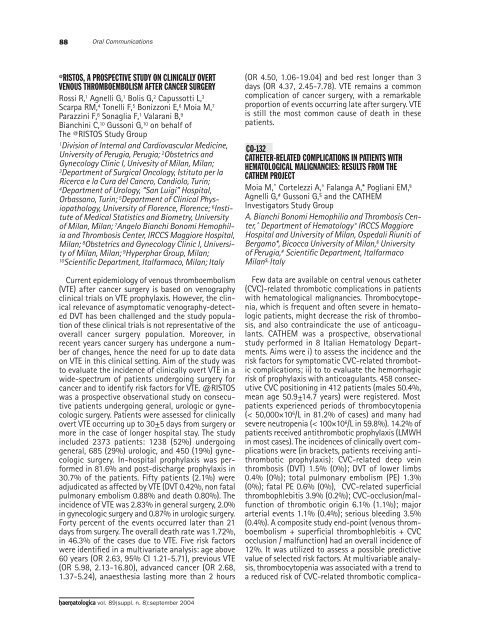Haematologica 2004;89: supplement no. 8 - Supplements ...
Haematologica 2004;89: supplement no. 8 - Supplements ...
Haematologica 2004;89: supplement no. 8 - Supplements ...
- No tags were found...
Create successful ePaper yourself
Turn your PDF publications into a flip-book with our unique Google optimized e-Paper software.
88Oral Communications@RISTOS, A PROSPECTIVE STUDY ON CLINICALLY OVERTVENOUS THROMBOEMBOLISM AFTER CANCER SURGERYRossi R, 1 Agnelli G, 1 Bolis G, 2 Capussotti L, 3Scarpa RM, 4 Tonelli F, 5 Bonizzoni E, 6 Moia M, 7Parazzini F, 8 Sonaglia F, 1 Valarani B, 9Bianchini C, 10 Gussoni G, 10 on behalf ofThe @ RISTOS Study Group1Division of Internal and Cardiovascular Medicine,University of Perugia, Perugia; 2 Obstetrics andGynecology Clinic I, Univesity of Milan, Milan;3Department of Surgical Oncology, Istituto per laRicerca e la Cura del Cancro, Candiolo, Turin;4Department of Urology, “San Luigi” Hospital,Orbassa<strong>no</strong>, Turin; 5 Department of Clinical Physiopathology,University of Florence, Florence; 6 Instituteof Medical Statistics and Biometry, Universityof Milan, Milan; 7 Angelo Bianchi Bo<strong>no</strong>mi Hemophiliaand Thrombosis Center, IRCCS Maggiore Hospital,Milan; 8 Obstetrics and Gynecology Clinic I, Universityof Milan, Milan; 9 Hyperphar Group, Milan;10Scientific Department, Italfarmaco, Milan; ItalyCurrent epidemiology of ve<strong>no</strong>us thromboembolism(VTE) after cancer surgery is based on ve<strong>no</strong>graphyclinical trials on VTE prophylaxis. However, the clinicalrelevance of asymptomatic ve<strong>no</strong>graphy-detectedDVT has been challenged and the study populatio<strong>no</strong>f these clinical trials is <strong>no</strong>t representative of theoverall cancer surgery population. Moreover, inrecent years cancer surgery has undergone a numberof changes, hence the need for up to date dataon VTE in this clinical setting. Aim of the study wasto evaluate the incidence of clinically overt VTE in awide-spectrum of patients undergoing surgery forcancer and to identify risk factors for VTE. @RISTOSwas a prospective observational study on consecutivepatients undergoing general, urologic or gynecologicsurgery. Patients were assessed for clinicallyovert VTE occurring up to 30±5 days from surgery ormore in the case of longer hospital stay. The studyincluded 2373 patients: 1238 (52%) undergoinggeneral, 685 (29%) urologic, and 450 (19%) gynecologicsurgery. In-hospital prophylaxis was performedin 81.6% and post-discharge prophylaxis in30.7% of the patients. Fifty patients (2.1%) wereadjudicated as affected by VTE (DVT 0.42%, <strong>no</strong>n fatalpulmonary embolism 0.88% and death 0.80%). Theincidence of VTE was 2.83% in general surgery, 2.0%in gynecologic surgery and 0.87% in urologic surgery.Forty percent of the events occurred later than 21days from surgery. The overall death rate was 1.72%,in 46.3% of the cases due to VTE. Five risk factorswere identified in a multivariate analysis: age above60 years (OR 2.63, 95% CI 1.21-5.71), previous VTE(OR 5.98, 2.13-16.80), advanced cancer (OR 2.68,1.37-5.24), anaesthesia lasting more than 2 hours(OR 4.50, 1.06-19.04) and bed rest longer than 3days (OR 4.37, 2.45-7.78). VTE remains a commoncomplication of cancer surgery, with a remarkableproportion of events occurring late after surgery. VTEis still the most common cause of death in thesepatients.CO-132CATHETER-RELATED COMPLICATIONS IN PATIENTS WITHHEMATOLOGICAL MALIGNANCIES: RESULTS FROM THECATHEM PROJECTMoia M,^ Cortelezzi A,° Falanga A,* Pogliani EM, §Agnelli G, # Gussoni G, $ and the CATHEMInvestigators Study GroupA. Bianchi Bo<strong>no</strong>mi Hemophilia and Thrombosis Center,^Department of Hematology° IRCCS MaggioreHospital and University of Milan, Ospedali Riuniti ofBergamo*, Bicocca University of Milan, § Universityof Perugia, # Scientific Department, ItalfarmacoMilan $, ItalyFew data are available on central ve<strong>no</strong>us catheter(CVC)-related thrombotic complications in patientswith hematological malignancies. Thrombocytopenia,which is frequent and often severe in hematologicpatients, might decrease the risk of thrombosis,and also contraindicate the use of anticoagulants.CATHEM was a prospective, observationalstudy performed in 8 Italian Hematology Departments.Aims were i) to assess the incidence and therisk factors for symptomatic CVC-related thromboticcomplications; ii) to to evaluate the hemorrhagicrisk of prophylaxis with anticoagulants. 458 consecutiveCVC positioning in 412 patients (males 50.4%,mean age 50.9±14.7 years) were registered. Mostpatients experienced periods of thrombocytopenia(< 50,000×10 6 /L in 81.2% of cases) and many hadsevere neutropenia (< 100×10 6 /L in 59.8%). 14.2% ofpatients received antithrombotic prophylaxis (LMWHin most cases). The incidences of clinically overt complicationswere (in brackets, patients receiving antithromboticprophylaxis): CVC-related deep veinthrombosis (DVT) 1.5% (0%); DVT of lower limbs0.4% (0%); total pulmonary embolism (PE) 1.3%(0%); fatal PE 0.6% (0%), CVC-related superficialthrombophlebitis 3.9% (0.2%); CVC-occlusion/malfunctio<strong>no</strong>f thrombotic origin 6.1% (1.1%); majorarterial events 1.1% (0.4%); serious bleeding 3.5%(0.4%). A composite study end-point (ve<strong>no</strong>us thromboembolism+ superficial thrombophlebitis + CVCocclusion / malfunction) had an overall incidence of12%. It was utilized to assess a possible predictivevalue of selected risk factors. At multivariable analysis,thrombocytopenia was associated with a trend toa reduced risk of CVC-related thrombotic complica-haematologica vol. <strong>89</strong>(suppl. n. 8):september <strong>2004</strong>
















